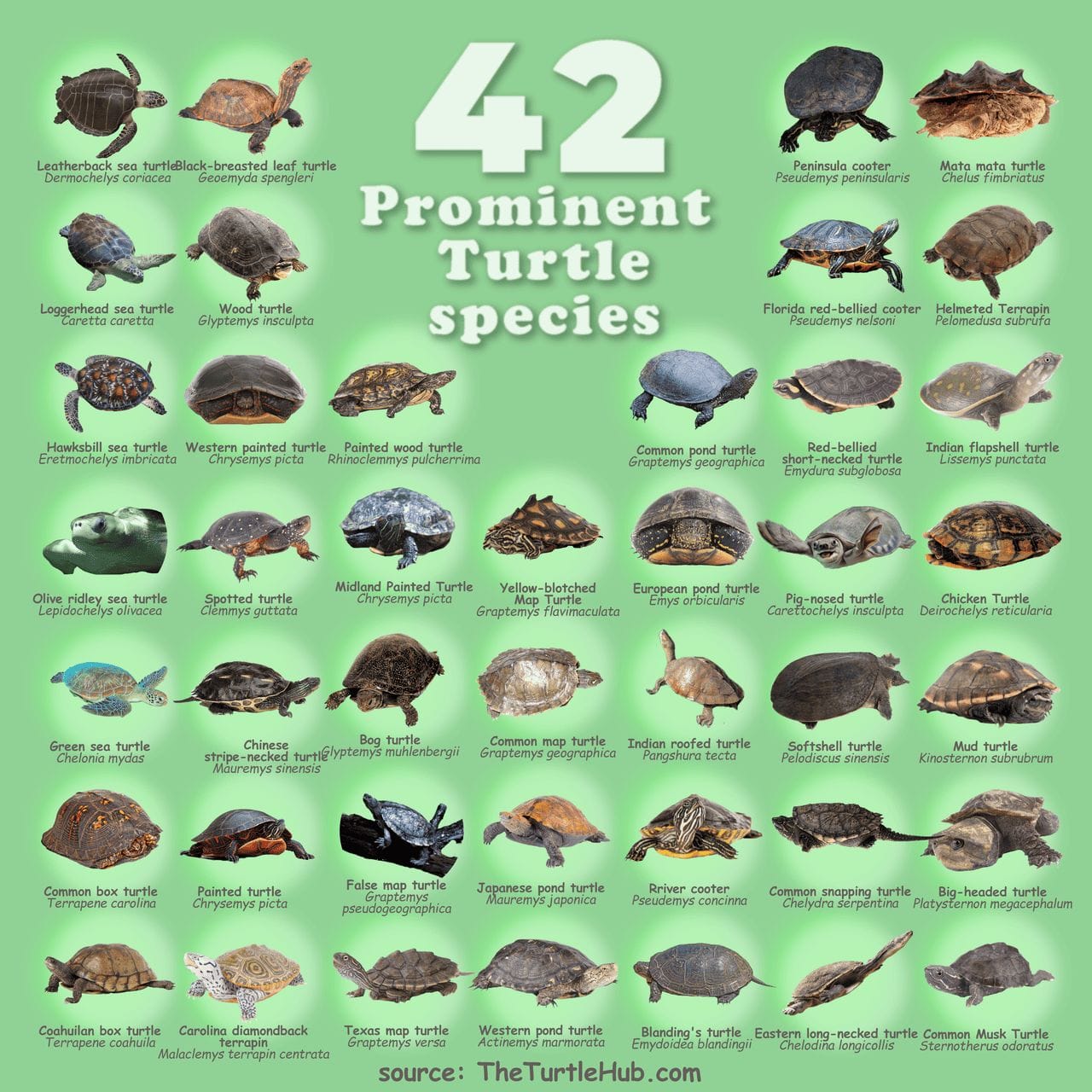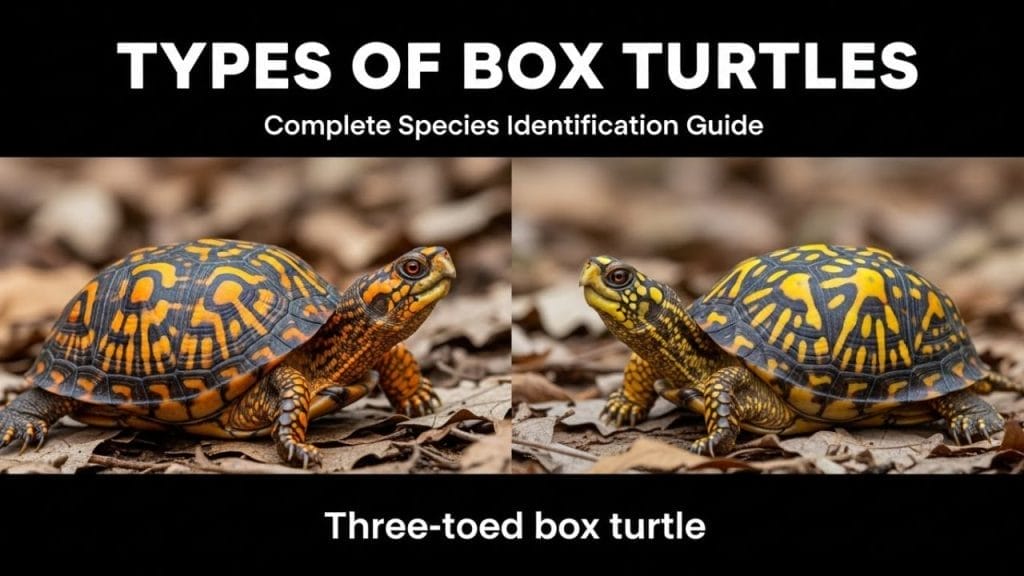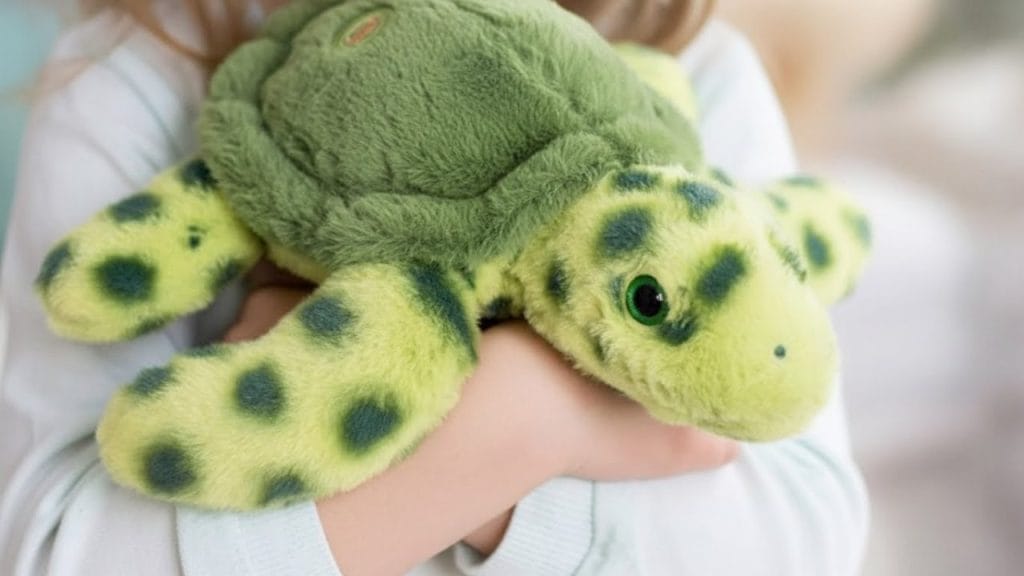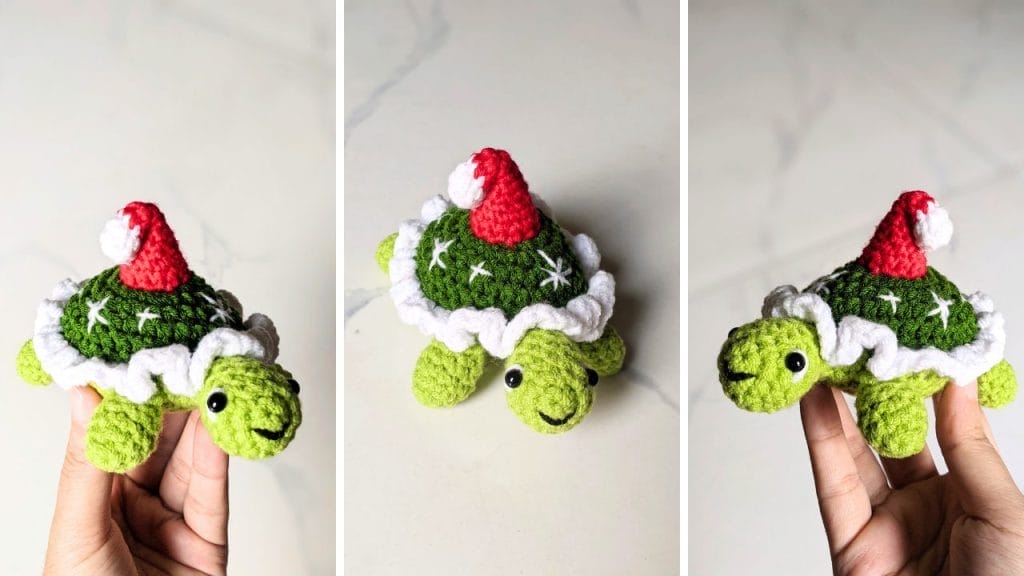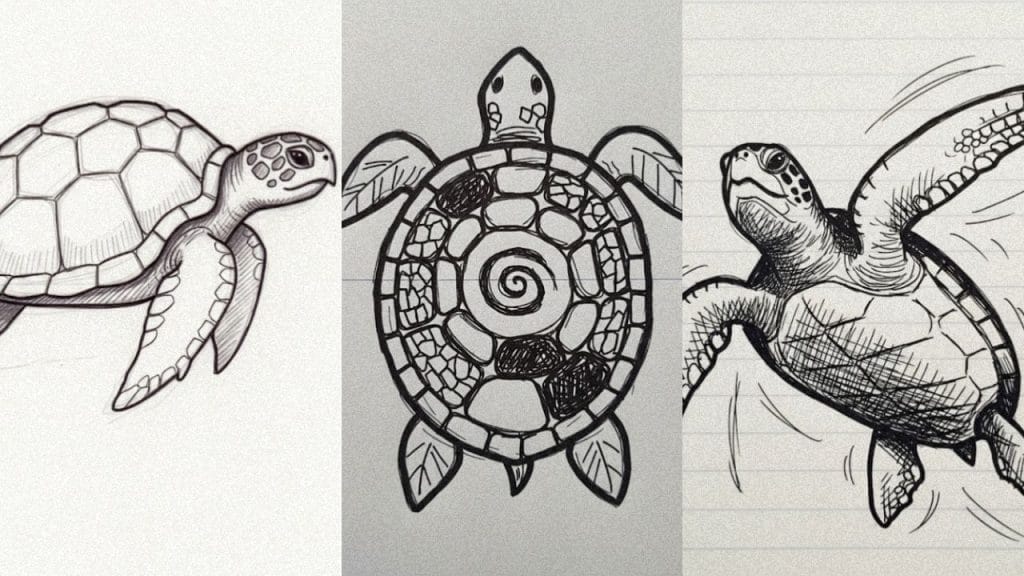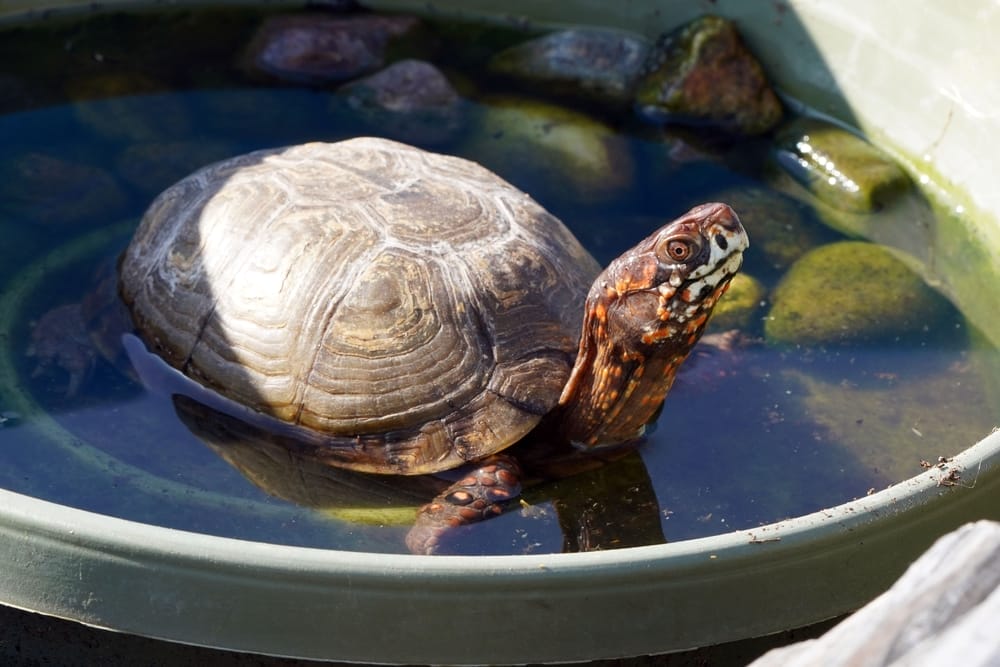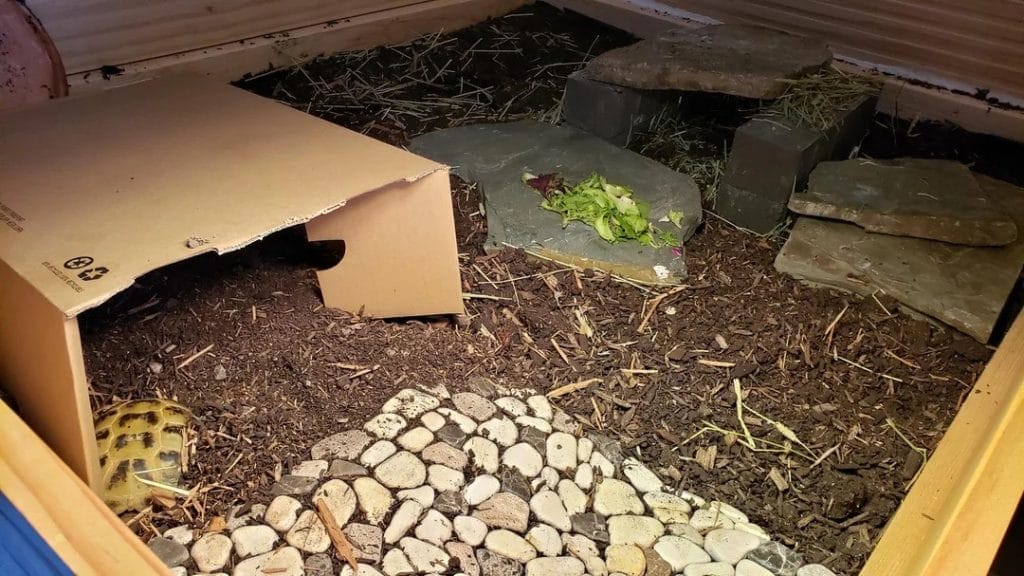17 Best Pet Turtles: Complete Species Guide for Beginners and Experts
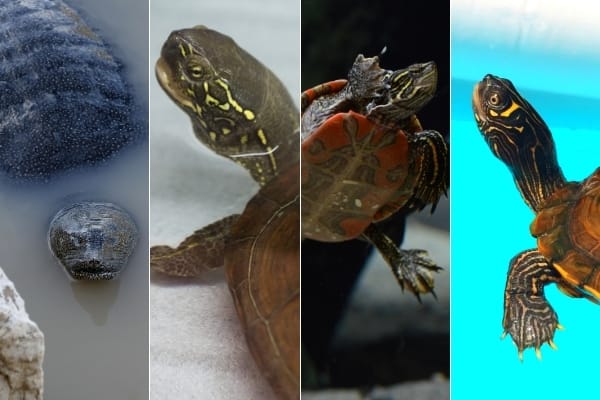
This post was created with help from AI tools and carefully reviewed by a human (Muntaseer Rahman). For more on how we use AI on this site, check out our Editorial Policy.
The 17 best pet turtle species are:
- Red-eared Slider
- Painted Turtle
- Eastern Box Turtle
- Mississippi Map Turtle
- Wood Turtle
- African Sideneck Turtle
- Caspian Pond Turtle
- Reeve’s Turtle
- Cooter Turtle
- Razor-backed Musk Turtle
- Softshell Turtle
- Common Musk Turtle
- Common Mud Turtle
- Diamondback Terrapin
- Spotted Turtle
- Yellow-bellied Slider, and
- Pink-bellied Sideneck Turtle.
Each species has unique care requirements, size ranges (4-16 inches), lifespans (20-80 years), and temperaments.
This guide covers habitat needs, feeding requirements, beginner-friendliness, and legal considerations to help you choose the perfect pet turtle.
Insert this critical context:
Important: Choosing a Species vs. Setting Up Properly
This guide helps you choose the RIGHT turtle species for your situation. But here’s what it doesn’t cover: the specific equipment you’ll need to keep that turtle healthy.
The reality: Every species on this list requires:
- Powerful canister filtration (not the filters pet stores recommend)
- Proper UVB lighting (specific bulbs, not “any basking lamp”)
- Adequate heating equipment (water heaters + basking lamps)
- Quality food and calcium supplements
- Water treatment supplies
Choosing a species is Step 1. Getting the right equipment is Step 2.
This guide provides care overviews for each species. For detailed equipment recommendations, setup instructions, and product specifications, see our Complete Turtle Owner Essentials Guide.
Quick equipment reality check:
- Tank: $50-200 (depending on size)
- Canister filter: $100-300 (most critical investment)
- UVB lighting: $50-120 (must be replaced every 6-12 months)
- Heating equipment: $40-80 (water heater + basking lamp)
- Food & supplements: $30-50 initial, then $20-40/month
- Water treatment: $25-40 (conditioner + test kit)
Total initial setup: $400-800 depending on species size
Now let’s find your perfect turtle species.
Warning: You Might Spend Hours Here
I’ve built the ultimate turtle and tortoise species database. This isn’t your average turtle list. Filter by genus, conservation status, and more. How many species? Which are endangered? What’s the tiniest one? It’s all there.
Quick Comparison: Best Pet Turtles by Category
| Category | Best Species | Why |
|---|---|---|
| Best for Beginners | Red-eared Slider, Painted Turtle, Box Turtle | Hardy, readily available, moderate care needs |
| Smallest Turtles | Common Musk (4-5″), Spotted Turtle (4-6″), Mud Turtle (5″) | Perfect for limited space |
| Most Interactive | Reeve’s Turtle, Red-eared Slider | Tolerate handling, recognize owners |
| Longest Living | Box Turtle (40-100 years), African Sideneck (50+ years) | Lifetime companions |
| Easiest Care | Musk Turtle, Mud Turtle | Small tanks, simple requirements |
| Most Colorful | Painted Turtle, Yellow-bellied Slider, Pink-bellied Sideneck | Striking patterns and colors |
| Best for Large Tanks | Cooter Turtle, Softshell Turtle | Active swimmers needing 75-100+ gallons |

This Hilarious Turtle Book Might Know Your Pet Better Than You Do
Let’s be real—most turtle care guides feel like reading a textbook written by a sleep-deprived zookeeper.
This one’s not that.
Told from the snarky point of view of a grumpy, judgmental turtle, 21 Turtle Truths You’ll Never Read in a Care Guide is packed with sarcasm, sass, and surprisingly useful insights.
And hey—you don’t have to commit to the whole thing just yet.
Grab 2 free truths from the ebook and get a taste of what your turtle really thinks about your setup, your food choices, and that weird plastic palm tree.
It’s funny, it’s honest, and if you’ve ever owned a turtle who glares at you like you’re the problem—you’ll feel seen.
Understanding Pet Turtle Categories
Before diving into specific species, it’s important to understand the three main categories of pet turtles and their fundamental care differences.
Aquatic Turtles
Definition: Spend 90-100% of their time in water. Strong swimmers requiring deep water and minimal land area.
Tank requirements: Large water volume (75-100+ gallons for adults), powerful filtration, basking platform.
Examples: Red-eared Sliders, Painted Turtles, Map Turtles, Cooter Turtles
Pros: Active, interesting to watch, excellent swimmers
Cons: Messy (produce lots of waste), require large tanks, expensive filtration
Semi-Aquatic Turtles
Definition: Split time between water and land. Need both swimming areas and terrestrial space.
Tank requirements: 50-50 water-to-land ratio, moderate filtration, accessible basking areas.
Examples: Musk Turtles, Mud Turtles, Spotted Turtles, Sideneck Turtles
Pros: Versatile, interesting behaviors, moderate tank size
Cons: More complex habitat setup, need both aquatic and terrestrial features
Terrestrial Turtles (Tortoises)
Definition: Primarily land-dwelling. Need minimal water (shallow dish for soaking only).
Tank requirements: Large floor space, substrate for burrowing, no deep water.
Examples: Box Turtles (technically semi-aquatic but mostly terrestrial)
Pros: Don’t require filtration, easier water maintenance, engaging personalities
Cons: Need very large enclosures, outdoor space ideal, specific humidity requirements
17 Best Types of Pet Turtles:
Here is a list of my 17 favorite types of turtles to have as pets:

1. Red-Eared Slider
- Scientific Name: Trachemys scripta elegans
- Size: 6-12 inches (females larger)
- Lifespan: 20-40 years (up to 50+ with excellent care)
- Care Level: Beginner to Intermediate
- Tank Size: 75-100 gallons for adults
- Water Temperature: 75-80°F
- Basking Temperature: 88-95°F
Why They’re Popular
Red-eared Sliders are the most common pet turtle in America for good reason. They’re hardy, adaptable, readily available, and relatively affordable. The distinctive red patch behind each eye makes them instantly recognizable.
Physical Characteristics
Appearance: Bright green shell with yellow stripes, bold red “ear” marking behind each eye. Skin features yellow and green stripes.
Sexual dimorphism: Females grow significantly larger (10-12 inches) than males (6-8 inches). Males develop elongated front claws for courtship displays.
Shell shape: Smooth, streamlined carapace ideal for swimming.
Habitat Requirements
Tank size: Start with 40 gallons for juveniles. Adults need minimum 75-100 gallons. Follow the rule: 10 gallons per inch of shell length.
Water depth: At least 1.5-2 times the turtle’s shell length to allow swimming and diving.
Filtration: Powerful canister filter essential. Sliders are messy eaters and produce significant waste.
Basking area: Must accommodate turtle’s entire body to dry completely. Use floating dock, DIY platform, or above-tank basking area.
Lighting: UVB light (10-12 hours daily) for shell health and vitamin D3 synthesis. Heat lamp for basking spot.
Water quality: Weekly partial water changes (25-30%) even with good filtration.
Diet and Feeding
Juveniles (under 2 years): 70-80% protein. Daily feeding of commercial turtle pellets, insects (crickets, mealworms), small fish, earthworms.
Adults: 50-60% vegetables. Feed every other day. Offer leafy greens (kale, collard greens, dandelion), aquatic plants (duckweed, water lettuce), occasional protein.
Feeding method: Always feed in water. Sliders cannot produce saliva and need water to swallow.
Supplements: Calcium powder (cuttlebone in tank), occasional vitamin supplement.
Temperament and Behavior
Activity level: Highly active, strong swimmers. Spend hours swimming, exploring, and basking.
Personality: Curious and alert. Learn to recognize feeding time and owners. May beg for food when people approach.
Handling: Tolerate brief handling but prefer to be left alone. Can scratch with sharp claws. Some individuals bite if frightened.
Social behavior: Can coexist with other sliders if tank is large enough, though males may become territorial during breeding season.
Hibernation
In the wild, Red-eared Sliders brumate (reptile hibernation) when water temperature drops below 50°F. Captive sliders don’t need to hibernate if kept at proper temperatures year-round. Many owners prefer to prevent hibernation by maintaining stable temperatures.
Special Considerations
- Growth rate: Fast-growing. Hatchlings (1-2 inches) reach adult size in 4-5 years with proper diet.
- Longevity: Long-term commitment. 20-30 years is typical; 40-50 years is possible.
- Escape artists: Sliders are strong and determined. Ensure tank has secure lid or high walls.
- Availability: Widely available at pet stores, online, and from breeders. Choose captive-bred over wild-caught.
- Cost: Hatchlings: $10-30. Setup costs: $300-600 for proper tank, filter, lights, decorations.
Best For
Beginners willing to commit to large tank requirements. People who enjoy watching active, swimming turtles. Owners with space for 75-100 gallon tanks.

2. Painted Turtle:
- Scientific Name: Chrysemys picta (4 subspecies)
- Size: 4-10 inches (varies by subspecies)
- Lifespan: 20-30 years
- Care Level: Beginner
- Tank Size: 55-75 gallons for adults
- Water Temperature: 75-80°F
- Basking Temperature: 85-90°F
Why They’re Popular
Painted Turtles are one of North America’s most colorful native species, featuring bright red, yellow, and orange markings. They’re hardy, readily available, and slightly smaller than Red-eared Sliders, making them ideal for beginners with moderate space.
Physical Characteristics
Appearance: Dark olive to black shell with red or yellow markings on marginal scutes (shell edges). Brightly colored head, legs, and tail with red and yellow stripes.
Subspecies differences:
- Eastern Painted (4.5-6″): Aligned shell scutes, plain yellow plastron
- Midland Painted (5-7″): Dark blotch on plastron, yellow line through eye
- Western Painted (6-10″): Largest subspecies, intricate patterns
- Southern Painted (4-5″): Distinctive red dorsal stripe down center of shell
Habitat Requirements
Tank size: 40-55 gallons for smaller subspecies (Eastern, Southern). 75 gallons for Western Painted Turtles.
Water depth: Moderate swimmers. Depth of 8-12 inches suitable for most painted turtles.
Basking: Enthusiastic baskers. Require stable, accessible basking platform and proper lighting setup.
Temperature: Slightly cooler than sliders. Water 72-78°F, basking 85-90°F.
Substrate: Optional. Bare bottom easier to clean. If using substrate, choose large river rocks that cannot be swallowed.
Diet and Feeding
Omnivorous with age shift: Juveniles eat 70% protein. Adults shift to 60% vegetation.
Protein sources: Commercial turtle pellets, insects (crickets, mealworms, waxworms), small fish, earthworms.
Vegetation: Aquatic plants (duckweed, water hyacinth), leafy greens (romaine, kale), occasional fruits.
Feeding frequency: Juveniles daily. Adults every other day.
Temperament and Behavior
Personality: Docile and calm. Less aggressive than sliders. Tolerate gentle handling better than most aquatic species.
Activity: Active during day. Spend mornings basking, afternoons swimming and foraging.
Social: Peaceful with other turtles. Often seen basking in groups in the wild, stacked on top of each other on logs.
Intelligence: Recognize feeding schedules and owners. May swim to front of tank when people approach.
Best For
Beginners seeking colorful, hardy turtles. Families with children (docile nature). Owners wanting slightly smaller alternative to Red-eared Sliders.
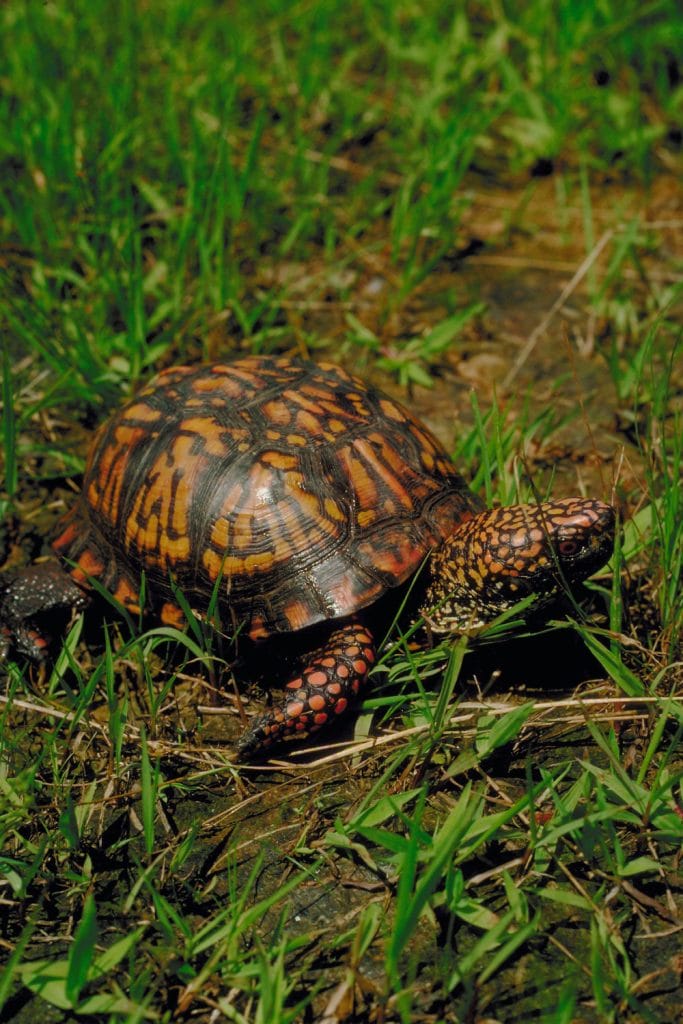
3. Box Turtles:
- Scientific Name: Terrapene carolina carolina
- Size: 5-7 inches
- Lifespan: 40-100+ years
- Care Level: Intermediate to Advanced
- Enclosure Size: 4×8 feet minimum (outdoor preferred)
- Temperature: 75-85°F (daytime), 65-70°F (nighttime)
Why They’re Unique
Box Turtles are primarily terrestrial, making them fundamentally different from aquatic species. They have distinctive hinged plastrons that close completely, sealing them inside their shells like a box. They’re one of the longest-lived turtle species in captivity.
Physical Characteristics
Shell: High-domed carapace. Color varies from brown to black with yellow, orange, or red markings. Each individual has unique pattern.
Hinged plastron: Two-part bottom shell with hinge. When threatened, the turtle pulls head and limbs inside and closes plastron tightly.
Feet: Unlike aquatic turtles, box turtles have non-webbed feet adapted for walking on land.
Eyes: Males typically have red/orange eyes. Females have brown/yellow eyes.
Habitat Requirements
Enclosure type: Outdoor pen strongly preferred (year-round in warm climates, seasonal in temperate zones). Indoor options: large turtle table, custom enclosure, or dedicated room.
Size: Minimum 4×8 feet floor space. Larger is always better. Box turtles are surprisingly active and need room to roam.
Substrate: Deep substrate (4-6 inches) for burrowing. Mix of topsoil, sand, and cypress mulch. Include leaf litter for natural environment.
Humidity: 60-80% humidity essential. Mist enclosure daily. Low humidity causes respiratory infections and eye problems.
Water: Shallow water dish for soaking (3-4 inches deep). Change daily as box turtles defecate in water.
Hiding spots: Multiple hiding areas (cork bark, half-buried flower pots, commercial hides).
Temperature gradient: Warm side 80-85°F, cool side 70-75°F. Nighttime drop to 65-70°F.
Lighting: UVB light if kept indoors. Natural sunlight ideal for outdoor enclosures.
Diet and Feeding
Omnivorous: 50% protein, 50% vegetation.
Protein: Earthworms, slugs, snails, crickets, mealworms, occasional pinkie mice, boiled egg.
Vegetables: Dark leafy greens, squash, green beans, peas, carrots.
Fruits: Strawberries, blueberries, melon, tomatoes (treats only, 10% of diet).
Mushrooms: Many box turtles love mushrooms. Offer shiitake, oyster, or button mushrooms.
Feeding schedule: Adults every other day. Variety is crucial.
Calcium: Dust food with calcium powder 2-3 times weekly.
Temperament and Behavior
Personality: Gentle and curious. Each individual has distinct personality. Some are bold and active; others are shy.
Intelligence: Highly intelligent for reptiles. Learn feeding locations, recognize owners, remember escape routes.
Homing instinct: Strong attachment to territory. Never relocate wild box turtles far from where found—they will spend rest of life trying to return home and often die trying.
Activity: Most active morning and evening. May bury themselves during midday heat or extended periods of hot/cold weather.
Lifespan: Truly lifetime pets. Many live 50-80 years; some exceed 100 years.
Hibernation
Wild box turtles hibernate (brumate) 3-5 months in winter, burrowing underground below frost line. Captive box turtles can hibernate if outdoor temperatures drop naturally, or hibernation can be prevented by bringing them indoors with controlled temperatures. First-time owners should avoid allowing hibernation until experienced.
Special Considerations
Legal restrictions: Many states restrict or prohibit keeping native box turtles as pets. Check state wildlife regulations before acquiring.
Wild vs. captive-bred: Only acquire captive-bred box turtles. Wild populations are declining. Wild-caught adults often refuse to eat in captivity and may carry diseases.
Long-term commitment: These turtles may outlive their owners. Have a plan for their care if something happens to you.
Outdoor housing challenges: Predators (raccoons, opossums, dogs) can injure or kill box turtles. Enclosures need secure lids or fencing buried 12+ inches to prevent digging.
Best For
Experienced keepers. People with outdoor space for large enclosures. Owners willing to commit to potentially 50-100 year lifespan. Those who prefer terrestrial pets over aquatic.

4. Mississippi Map Turtles
- Scientific Name: Graptemys pseudogeographica kohnii
- Size: Males 3.5-5 inches, Females 6-10 inches
- Lifespan: 30-50 years
- Care Level: Intermediate to Advanced
- Tank Size: 75-100 gallons (females)
- Water Temperature: 74-78°F
- Basking Temperature: 90-95°F
Why They’re Distinctive
Map Turtles get their name from the map-like markings on their shells. They’re also called “sawback” turtles due to the raised, serrated ridge down their spine. More challenging than sliders or painted turtles, they’re best for keepers with some turtle experience.
Physical Characteristics
Shell: Olive to brown with intricate yellow or orange lines resembling contour lines on maps. Pronounced keel (ridge) along vertebral scutes creates sawback appearance.
Sexual dimorphism: Extreme size difference. Females grow 2-3 times larger than males.
Head markings: Yellow lines on head and neck create distinctive pattern.
Habitat Requirements
Water quality: Map turtles are extremely sensitive to water quality. Require pristine conditions or develop health issues.
Filtration: Heavy-duty canister filter essential. Consider two filters for redundancy.
Water changes: More frequent than other species. 30-40% weekly.
Current: Prefer flowing water over still ponds. Use powerhead or position filter outlet to create gentle current.
Basking: Shy baskers. Need secure, elevated basking platform away from disturbances.
Tank size: Larger than other species due to extreme sexual dimorphism. If keeping multiple, account for large female size.
Diet and Feeding
Omnivorous: 60-70% protein as juveniles. Adults shift toward 50-60% vegetation.
Protein: High-quality commercial pellets, fish (guppies, goldfish), insects, shrimp, crayfish.
Caution on protein: Overfeeding protein causes pyramiding (abnormal shell growth).
Vegetables: Offer daily even if initially refused. Leafy greens, aquatic plants, occasional fruits.
Temperament and Behavior
Skittish: More nervous than sliders or painted turtles. Startle easily and dash for water when approached.
Basking behavior: Bask in early morning before significant activity. Return to water quickly if disturbed.
Social: Can be kept together if tank is large enough and turtles are similar size.
Handling: Dislike handling. Stress easily. Best kept as observation pets.
Best For
Intermediate to advanced keepers. Those with experience maintaining excellent water quality. People who enjoy observing turtles rather than handling them. Owners willing to invest in high-quality filtration.

5. Wood Turtle:
- Scientific Name: Glyptemys insculpta
- Size: 6-9 inches
- Lifespan: 40-58 years
- Care Level: Advanced
- Enclosure Size: Large (84+ inches for indoor)
- Temperature: 75-85°F
- Water Temperature: 75-80°F
Special Note on Conservation
Wood Turtles are listed as Endangered (IUCN Red List). Many states prohibit ownership or require special permits. Before considering a Wood Turtle, verify legality in your state. Only acquire captive-bred individuals from licensed breeders with proper documentation.
Physical Characteristics
Shell: Sculpted appearance with prominent growth rings creating pyramid-like texture. Brown and tan coloring.
Skin: Bright orange-red coloration on neck and legs. Gives them common name “Old Red Leg.”
Feet: Partially webbed, adapted for both land and water.
Habitat Requirements
Semi-aquatic: Need both substantial land area and swimming water.
Land area: 75% of enclosure. Deep substrate for burrowing.
Water area: 25% of enclosure. Shallow pool (4-6 inches deep) for soaking and swimming.
Substrate: Mix of topsoil, sand, and cypress mulch. Maintain humidity.
Temperature: Basking spot 85-88°F, cool end 70-75°F.
Diet and Feeding
Carnivore-leaning omnivore: Prefer animal protein.
Protein: Earthworms, slugs, insects, occasional fish, high-quality cat food (sparingly).
Vegetation: Dark leafy greens, berries, mushrooms.
Feeding frequency: Adults 3-4 times per week.
Temperament
Intelligence: Among most intelligent turtle species. Curious, alert, and interactive.
Personality: Bold and curious. More personable than many aquatic species.
Handling: Tolerate brief handling better than fully aquatic species.
Best For
Advanced keepers only. Those committed to conservation (only keep captive-bred). Owners with space for large, complex enclosures. People in states where legal with proper permits.

6. African Aquatic Sideneck Turtle:
- Scientific Name: Pelusios castaneus
- Size: 8-10 inches (occasionally larger)
- Lifespan: 25-50 years
- Care Level: Beginner to Intermediate
- Tank Size: 75-100 gallons
- Water Temperature: 78-82°F
- Basking Temperature: 90-95°F
Why They’re Unique
Sideneck turtles are named for their inability to retract their heads straight back into their shells. Instead, they fold their necks sideways, tucking heads under the front edge of the carapace. This unique adaptation makes them fascinating to observe.
Physical Characteristics
Shell: Dark brown to black. Oval-shaped and relatively flat.
Plastron: Dark gray with yellow patches.
Head: Brown or olive with dark markings. Many owners note they appear to be “smiling” due to mouth shape.
Neck: Long neck that folds sideways rather than retracting straight back.
Claws: Sharp claws; feet are not fully webbed.
Habitat Requirements
Tank size: 40 gallons for single turtle. Add 20 gallons per additional turtle.
Water depth: Minimum 8-10 inches. These are strong swimmers despite stocky appearance.
Basking: Essential despite being highly aquatic. Must be able to dry off completely.
Filtration: Powerful canister filter. Sidenecks are messy.
Temperature: Warmer than North American species. Keep water 78-82°F consistently.
Diet and Feeding
Omnivorous: Age-related shift in diet composition.
Juveniles: 80% protein. Feed daily.
Adults: 60% protein, 40% vegetation. Feed every other day.
Protein: Commercial pellets, fish, insects, earthworms, cooked chicken, snails.
Vegetables: Dark leafy greens, dandelions, collard greens.
Important: Offer varied diet from young age to prevent food fixation.
Temperament
Activity level: Active during day. Entertaining to watch swimming and foraging.
Personality: Generally docile but can be shy. Each individual has distinct personality.
Handling: Tolerate brief handling but have sharp claws. Use caution.
Social: Can be kept in groups if tank is adequately sized.
Hibernation
African Sidenecks do NOT hibernate. Maintain warm temperatures year-round. If temperatures drop below 70°F, use aquarium heater.
Best For
Beginners to intermediate keepers. Those who want active, daytime turtles. People willing to maintain warmer temperatures. Owners seeking unique appearance (sideneck characteristic).

7. Caspian Pond Turtle:
- Scientific Name: Mauremys rivulata
- Size: 7-9 inches
- Lifespan: 30-40 years
- Care Level: Intermediate
- Tank Size: 75-100 gallons
- Water Temperature: 75-78°F
- Basking Temperature: 85-90°F
Origin and Characteristics
Native to Middle East and southeastern Europe. Attractive olive or tan shells with yellow markings create striking appearance. Known for recognizing owners over time.
Physical Characteristics
Shell: Smooth, oval carapace. Olive or tan with cream or yellow markings on each scute.
Head and limbs: Yellow or cream stripes on dark background.
Size difference: Males smaller (6-7″) than females (8-9″).
Habitat Requirements
Tank: Minimum 75 gallons. Plastic tubs or outdoor ponds preferred over glass aquariums.
Water depth: Moderate to deep. 12-18 inches suitable.
Substrate: Not required. Bare bottom tanks easier to maintain.
Basking: Large basking platform essential.
Filtration: Powerful filter necessary for water quality.
Diet
Juveniles: Primarily carnivorous. Fish, insects, worms, commercial pellets.
Adults: Omnivorous. 50-50 protein and vegetation. Leafy greens, vegetables, continued protein sources.
Feeding: Daily for juveniles, every other day for adults.
Temperament
Recognition: Learn to recognize owners. May swim to front of tank when familiar person approaches.
Activity: Active swimmers, enthusiastic baskers.
Handling: Tolerate minimal handling. Prefer to be observed.
Hibernation
In the wild, Caspian Pond Turtles hibernate. Captive individuals can be kept active year-round by maintaining proper temperatures, or allowed to hibernate if owner is experienced.
Best For
Intermediate keepers. Those who want turtles that recognize them. People seeking European/Middle Eastern species rather than common North American turtles.

8. Reeve’s Turtle:
- Scientific Name: Mauremys reevesii
- Size: 4-6 inches
- Lifespan: 20-25 years
- Care Level: Beginner
- Tank Size: 30-40 gallons
- Water Temperature: 70-75°F
- Basking Temperature: 85-90°F
Why They’re Beginner-Friendly
Reeve’s Turtles are unique among aquatic turtles for enjoying human interaction. They tolerate handling better than most species, making them ideal first turtles. Small size also makes housing more manageable.
Physical Characteristics
Shell: Three raised keels (ridges) running length of carapace from front to back. Keels are prominent in juveniles, may flatten slightly with age.
Color: Dark brown to black shell with incomplete yellow lines on head and neck.
Size: One of the smaller aquatic species. 4-6 inches adult length.
Habitat Requirements
Tank size: 15-20 gallons for juveniles. 30-40 gallons for adults.
Water depth: Shallow water essential. Reeve’s Turtles are poor swimmers. Water depth should not exceed 6-8 inches.
Swimming aids: Provide rocks, driftwood, or plants to help turtle reach surface and basking area easily.
Basking: Accessible platform with proper lighting and heating.
Hiding spots: Shy species. Provide caves or dense plant cover.
Diet
Omnivorous: 60% protein, 40% vegetation.
Protein: Commercial turtle pellets, earthworms, insects, small fish, chopped chicken.
Vegetables: Leafy greens, aquatic plants.
Feeding: Daily for juveniles, every other day for adults.
Temperament
Handling tolerance: Unusual for aquatic turtles, Reeve’s often enjoy gentle handling. Each individual varies.
Personality: Generally calm and docile. Less skittish than most aquatic species.
Activity: Active during day but not overly energetic.
Best For
First-time turtle owners. Children (with supervision) due to docile nature. Small space limitations (apartments). People wanting interactive, handleable turtle.

9. Cooter Turtle:
- Scientific Name: Pseudemys concinna (multiple subspecies)
- Size: 9-16 inches (females larger)
- Lifespan: 30-40 years
- Care Level: Intermediate
- Tank Size: 100-150 gallons
- Water Temperature: 75-80°F
- Basking Temperature: 85-90°F
Subspecies
River Cooter: P. concinna concinna – Large, prefers flowing water
Florida Cooter: P. concinna floridana – Still or slow-moving water
Coastal Plain Cooter: P. concinna suwanniensis – Southeastern U.S.
Texas River Cooter: P. texana – Separate species often grouped with cooters
Red-bellied Cooter: Pseudemys rubriventris – Red coloring on plastron
Physical Characteristics
Size: Among larger pet turtle species. Females reach 13-16 inches; males 9-12 inches.
Shell: Dark with yellow or orange markings creating complex patterns.
Head: Distinctive yellow stripes on head and neck.
Plastron: Usually yellow, sometimes with dark markings. Red-bellied species have pink-red coloring.
Habitat Requirements
Tank size: Minimum 100 gallons. 150+ gallons ideal for large females.
Water depth: Deep water preferred. 18-24 inches or more.
Swimming space: Active swimmers need ample space to swim laps.
Filtration: Heavy-duty canister filter or multiple filters. Cooters are messy.
Outdoor option: Pond habitat ideal if climate appropriate.
Diet
Age-related shift: Juveniles are 80% carnivorous. Adults are 80% herbivorous.
Juveniles: Commercial pellets, fish, insects, worms.
Adults: Primarily vegetation. Aquatic plants, leafy greens, vegetables. Occasional protein.
Feeding: Juveniles daily. Adults every other day. Adults may graze on live plants constantly if provided.
Temperament
Activity: Very active swimmers. Constantly moving.
Personality: Alert and aware. May be nervous in small tanks. Calm in appropriately sized habitat.
Handling: Generally don’t enjoy handling. Scratch with sharp claws.
Best For
Intermediate keepers with space for very large tanks. Those willing to upgrade to 100-150 gallon tanks as turtles grow. People who enjoy watching active swimming. Owners with outdoor pond options.
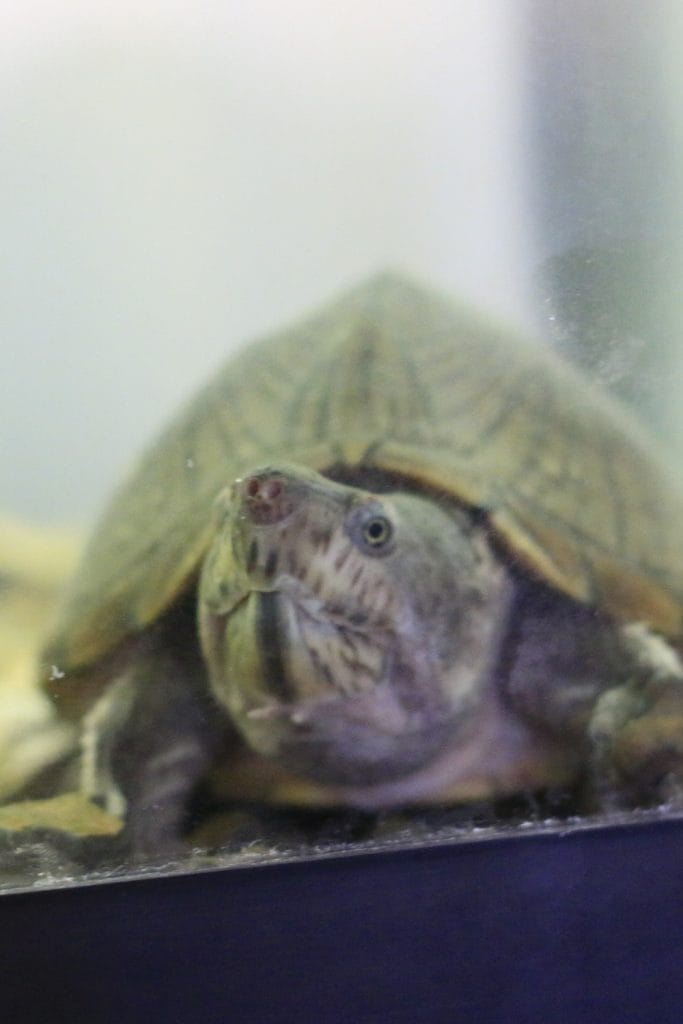
10. Razor-backed Musk Turtle:
- Scientific Name: Sternotherus carinatus
- Size: 5-6 inches
- Lifespan: 20-50 years
- Care Level: Beginner to Intermediate
- Tank Size: 40-55 gallons
- Water Temperature: 72-78°F
- Basking Temperature: 85-90°F
Characteristics
Shell: Distinctive sharp keel (ridge) running length of carapace, giving species its “razor-backed” name.
Head: Large head relative to body size. Long neck. Sharp beak.
Color: Tan or cream body with brown markings. Shell is brown to gray.
Size: Larger than Common Musk Turtles.
Habitat Requirements
Tank: 40-55 gallons for single adult.
Water depth: Deep water preferred. Razor-backs spend most time underwater, rarely basking.
Bottom-dwellers: Provide interesting bottom landscape with rocks, driftwood, hiding spots.
Basking: Although rarely used, basking platform should be available.
Filtration: Good filtration necessary.
Diet
Carnivorous: High protein diet.
Food: Commercial turtle pellets, insects, worms, crickets, snails, small fish.
Feeding: Daily for juveniles, every other day for adults.
Supplementation: Calcium dusting on food 2-3 times weekly.
Temperament
Aquatic lifestyle: Almost entirely aquatic. Surface only to breathe.
Activity: Active bottom-walkers. Interesting to watch foraging along substrate.
Handling: Don’t enjoy handling. May bite or release musk odor if stressed.
Best For
Beginners wanting small turtle. Those who prefer watching turtles underwater rather than basking. People seeking turtles that don’t require frequent basking light adjustments.

11. Softshell turtles:
- Scientific Name: Apalone species (Smooth Softshell, Spiny Softshell)
- Size: 7-15 inches (varies by species and sex)
- Lifespan: 25-50 years
- Care Level: Advanced
- Tank Size: 75-100+ gallons
- Water Temperature: 75-80°F
- Basking Temperature: 85-90°F
Why They’re Advanced
Softshells require pristine water conditions and are highly sensitive to skin damage. Their unique shell makes them vulnerable to injuries from sharp objects. Not recommended for first-time turtle owners.
Physical Characteristics
Shell: Soft, leathery shell instead of hard scutes. Flat, pancake-like shape.
Snout: Long, tubular snout used as snorkel. Can breathe while mostly submerged.
Feet: Highly webbed, paddle-like feet. Excellent swimmers.
Speed: Fastest swimmers of all freshwater turtles.
Aggression: Can be aggressive. Sharp beak delivers painful bite.
Habitat Requirements
Tank: Minimum 75-100 gallons depending on species. Larger for Spiny Softshells (which get bigger).
Water depth: Deep water preferred. 18-24 inches.
Substrate: Fine sand essential. Softshells bury themselves in sand to ambush prey and hide.
No sharp objects: Remove anything that could cut or puncture soft shell.
Water quality: Crystal clear water mandatory. Powerful filtration with large-capacity canister filter.
Basking: May or may not bask regularly. Provide option.
Diet
Carnivorous: Exclusively animal protein in wild, though some may accept vegetables in captivity.
Food: Commercial pellets (if accepted), live fish, insects, worms, snails, crayfish.
Feeding method: Place food in water. Natural ambush hunters.
Feeding frequency: Daily for juveniles, every other day for adults.
Temperament
Aggression: Can be aggressive, especially when feeding. Handle with extreme caution.
Biting: Fast strikers with powerful jaws. Bite can cause injury. Use long feeding tongs.
Stress: Highly strung. Stressed by frequent handling or tank disturbances.
Observational pet: Best kept as watching pets, not handling pets.
Best For
Advanced keepers with experience. Those willing to maintain pristine water quality. People who want unique-looking turtle. Owners comfortable with potentially aggressive pet.
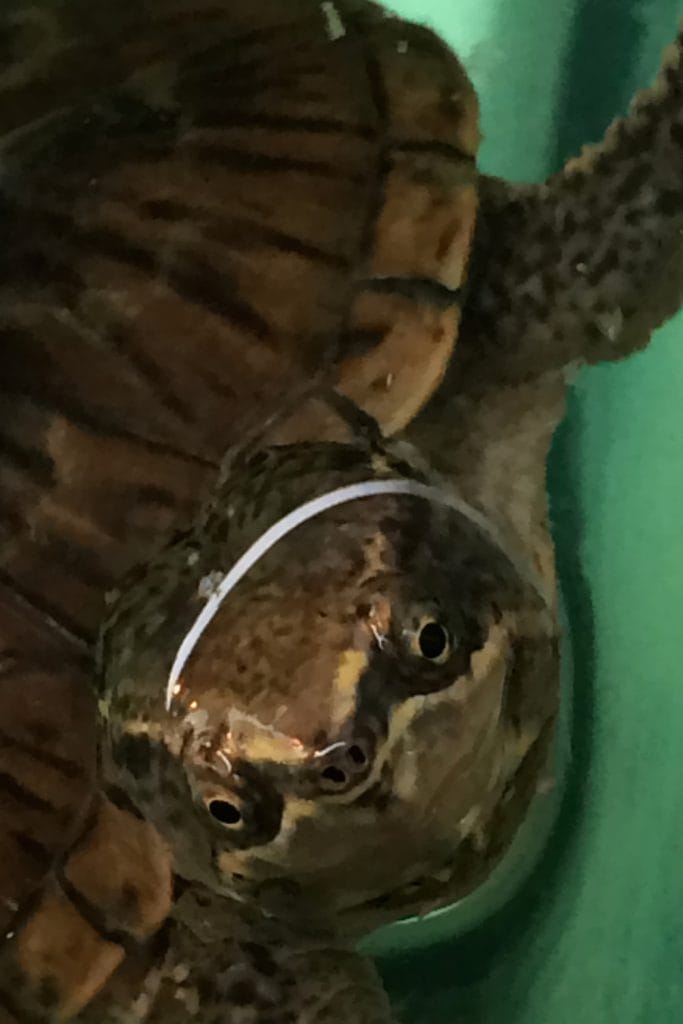
12. Common Musk Turtle
- Scientific Name: Sternotherus odoratus
- Size: 3-5 inches
- Lifespan: 30-50 years
- Care Level: Beginner
- Tank Size: 20-40 gallons
- Water Temperature: 72-78°F
- Basking Temperature: 85-90°F
Nickname Explanation
“Stinkpot” comes from their defense mechanism: releasing foul-smelling musk from glands when threatened. With gentle handling and low stress, musk release is rare.
Physical Characteristics
Size: One of smallest pet turtles. Adults only 3-4 inches typically.
Shell: Dark brown to black with visible keels. May have yellow stripes on head.
Barbels: Two barbels (whisker-like projections) on chin.
Plastron: Small, reduced plastron compared to other turtles.
Habitat Requirements
Tank: 20 gallons minimum. 30-40 gallons ideal.
Water depth: Shallow to moderate. Musk turtles are poor swimmers. 6-10 inches depth.
Bottom habitat: Spend most time walking on bottom. Provide interesting substrate, rocks, wood.
Climbing help: Provide structures leading to basking area. Poor climbers.
Basking: Less frequent baskers than other turtles but need option available.
Diet
Carnivorous: High protein diet.
Food: Small fish, aquatic insects, earthworms, crickets, bloodworms, commercial pellets.
Feeding: Daily for juveniles, every other day for adults.
Feeding location: Feed in water.
Temperament
Personality: Shy but curious once acclimated.
Handling: Tolerate brief, gentle handling when accustomed to owner. Stressed by rough or frequent handling.
Musk release: Rarely release musk if handled calmly and kept in good conditions.
Activity: Active bottom-walkers.
Hibernation
Wild musk turtles hibernate 2-4 months in winter. Captive turtles can be kept active year-round with stable temperatures or allowed to hibernate if conditions are controlled.
Best For
Beginners with limited space. Apartment dwellers. Those wanting smallest possible pet turtle. People who prefer watching turtles rather than handling. Budget-conscious owners (small tank = lower costs).

13. Common Mud Turtles
- Scientific Name: Kinosternon subrubrum
- Size: 3-5 inches
- Lifespan: 30-50 years
- Care Level: Beginner
- Tank Size: 20-40 gallons
- Water Temperature: 72-78°F
- Basking Temperature: 85-90°F
Similarity to Musk Turtles
Mud Turtles are often confused with Musk Turtles due to similar size and care requirements. Main differences: Mud Turtles have hinged plastrons allowing them to close shell partially, and they spend more time on land.
Physical Characteristics
Size: 3-5 inches adult length.
Shell: Dark brown, yellow, or olive green. Smooth, dome-shaped without keels (unlike musk turtles).
Plastron: Hinged plastron with two movable sections.
Head: Yellow or tan with dark markings.
Habitat Requirements
Semi-aquatic: More terrestrial than musk turtles. Provide substantial land area.
Tank: 20-40 gallons with 50-50 water-to-land ratio.
Water depth: Shallow water, 4-6 inches.
Land area: Substrate-filled land area for resting and summer basking.
Summer behavior: Often prefer land in mid-summer, water in spring/fall.
Diet
Omnivorous: Eat both animal and plant matter but prefer protein.
Food: Small fish, crabs, shrimp, earthworms, insects, chopped vegetables, commercial pellets.
Strong jaws: Can crush snails and small shellfish.
Feeding: Daily for juveniles, every other day for adults.
Temperament
Personality: Calm and docile once acclimated.
Musk release: Like musk turtles, can release odor when extremely stressed.
Handling: Tolerate gentle, brief handling.
Activity: More active than musk turtles, both in water and on land.
Hibernation
Outdoor mud turtles hibernate in winter, burrowing deep in mud. Can hibernate 4-6 months. Indoor turtles don’t need to hibernate if temperatures are stable.
Best For
Beginners wanting small turtle. Those who want both aquatic and terrestrial behaviors. Limited space (small tanks). People wanting long-lived small pet.

14. Diamondback Terrapins
- Scientific Name: Malaclemys terrapin
- Size: Males 4-5.5 inches, Females 6-10 inches
- Lifespan: 25-40 years
- Care Level: Advanced
- Tank Size: 55-75 gallons minimum
- Water: Brackish water required
- Water Temperature: 75-80°F
- Basking Temperature: 85-90°F
Unique Brackish Water Requirement
Diamondback Terrapins are the only turtle species in this guide requiring brackish (mixed fresh/salt) water. This makes them more challenging and expensive to maintain than freshwater species.
Physical Characteristics
Shell: Diamond-shaped scutes create distinctive pattern. Shell colors vary by subspecies: gray, brown, or black.
Skin: Ranges from pale gray to black. Many individuals have dark spots creating attractive patterns.
Seven subspecies: Different regions have distinct colorations and patterns.
Sexual dimorphism: Extreme size difference. Females nearly twice the size of males.
Habitat Requirements
Brackish water: Mix fresh and saltwater to specific gravity of 1.005-1.015. Requires hydrometer to measure salinity.
Salt: Use marine aquarium salt (not table salt). Follow package directions for brackish concentration.
pH: Maintain 6.8-7.0.
Water depth: Deep water needed. Strong swimmers despite relatively heavy shells.
Filtration: Must handle saltwater. Not all filters appropriate for brackish setups.
Water changes: Weekly partial changes. Remix brackish water to proper salinity.
Diet
Carnivorous: Almost exclusively animal protein.
Food: Small fish, aquatic snails, crabs, clams, mussels, shrimp, dried insects.
Strong jaws: Designed to crush shells of prey.
Some vegetables: May accept small amounts of leafy greens but not dietary staple.
Feeding: Daily for juveniles, every other day for adults.
Temperament
Social: Often prefer company of other terrapins. Can be kept in groups if tank is large enough.
Activity: Active swimmers. Engaging to watch.
Handling: Generally tolerate brief handling but prefer to be left alone.
Conservation Note
Diamondback Terrapins were heavily harvested historically for food. While no longer endangered, they face threats from habitat loss and boat strikes. Always purchase captive-bred individuals from reputable breeders.
Best For
Advanced keepers only. Those willing to maintain brackish water (extra complexity and cost). Experienced aquarists familiar with marine setups. People wanting unique, challenging turtle species.
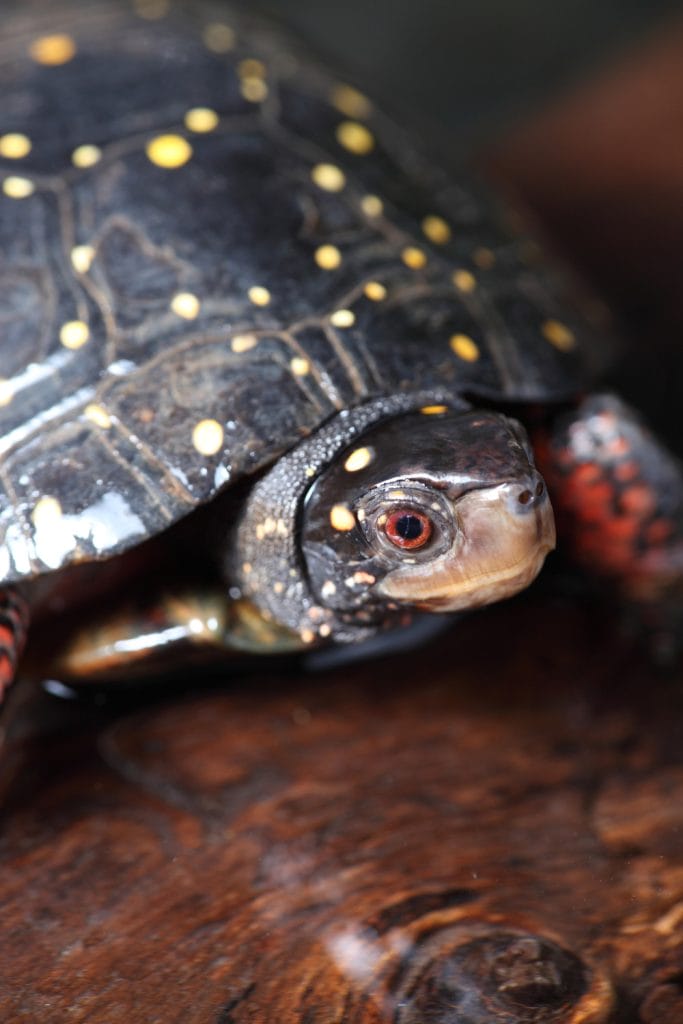
15. Spotted Turtles
- Scientific Name: Clemmys guttata
- Size: 4-5 inches
- Lifespan: 25-50 years
- Care Level: Intermediate
- Tank Size: 30-40 gallons
- Water Temperature: 70-75°F
- Basking Temperature: 85-88°F
Conservation Status
Spotted Turtles are listed as Endangered. Many states prohibit collection from wild. Only acquire captive-bred individuals from licensed breeders with documentation. Verify legality in your state before purchasing.
Physical Characteristics
Distinctive spots: Named for bright yellow or orange spots on dark shell and skin. Number and placement of spots varies by individual.
Size: One of smallest North American turtles. 3.5-5 inches.
Shell: Smooth, black shell with yellow spots.
Head and limbs: Black with yellow, orange, or red spotting.
Pattern uniqueness: Each turtle’s spot pattern is unique like fingerprints.
Habitat Requirements
Semi-aquatic: Need both water and land areas.
Poor swimmers: Shallow water essential. 4-6 inches depth maximum.
Tank: 30-40 gallons with good water-to-land ratio.
Climbing aids: Provide easy access from water to land. Not agile climbers.
Juveniles vs. adults: Young turtles more aquatic. Adults spend more time on land as they mature.
Temperature: Cooler than tropical species. 70-75°F water, 85-88°F basking.
Avoid fluctuations: Sensitive to temperature swings.
Diet
Omnivorous: Eat both protein and vegetation.
Protein: Earthworms, crickets, small fish, shrimp/krill, snails, bloodworms.
Vegetables: Dandelion greens, collard greens, watercress, aquatic plants.
Commercial: High-quality commercial turtle foods.
Strong beaks: Can crack snail shells and crush hard foods.
Feeding: Daily for juveniles, every other day for adults.
Temperament
Shy: More reserved than common pet species.
Calm: Gentle and non-aggressive once acclimated.
Handling: Tolerate gentle handling but stress easily with excessive contact.
Activity: Active during day. Most active in morning and evening.
Hibernation
Wild Spotted Turtles hibernate starting mid-October. Captive turtles can hibernate naturally if kept outdoors or hibernation can be prevented indoors with controlled temperatures. Inexperienced keepers should prevent hibernation initially.
Best For
Intermediate keepers. Those wanting small, attractive turtle. People committed to conservation (only captive-bred). Owners in states where legal. Those with controlled environments (sensitive to temperature fluctuations).

16. Yellow-Bellied Slider
- Scientific Name: Trachemys scripta scripta
- Size: Males 5-9 inches, Females 8-13 inches
- Lifespan: 20-40 years
- Care Level: Beginner
- Tank Size: 75-100 gallons
- Water Temperature: 72-80°F
- Basking Temperature: 90-95°F
Relation to Red-Eared Sliders
Yellow-bellied Sliders are a subspecies of the same species as Red-eared Sliders (Trachemys scripta). They share nearly identical care requirements and appearance except for key distinguishing feature.
Physical Characteristics
Main identifier: Bright yellow plastron (bottom shell) that gives them their name.
Shell: Dark brown or black carapace with yellow markings.
Skin: Olive-green with yellow stripes.
No red “ears”: Unlike Red-eared Sliders, they lack the red patch behind eyes. Have yellow markings instead.
Size: Similar to Red-eared Sliders with significant sexual dimorphism.
Habitat Requirements
Care requirements virtually identical to Red-eared Sliders:
Tank: 75-100 gallons for adults
Water depth: 1.5-2x shell length
Filtration: Powerful canister filter
Basking: Essential daily basking with proper lighting
Temperature: Water 72-80°F, basking 90-95°F
UVB: 10-12 hours daily
Diet
Age-related shift: Juveniles 70-80% carnivorous. Adults 60-70% herbivorous.
Juveniles: Commercial pellets, insects, small fish, worms. Daily feeding.
Adults: Leafy greens primary diet. Carrots, kale, parsley, collard greens, red bell peppers, aquatic plants. Every other day feeding.
Protein for adults: Occasional insects, worms, or fish as treats.
Temperament
Personality: Active, alert, curious. Similar to Red-eared Sliders in behavior.
Intelligence: Recognize owners and feeding schedules.
Social: Can coexist with other sliders if tank is adequately sized.
Handling: Tolerate brief handling. Sharp claws require caution.
Best For
Beginners wanting slider without red ear markings. Those who want active, engaging turtle. Owners with space for large tanks. People seeking hardy, readily available species.
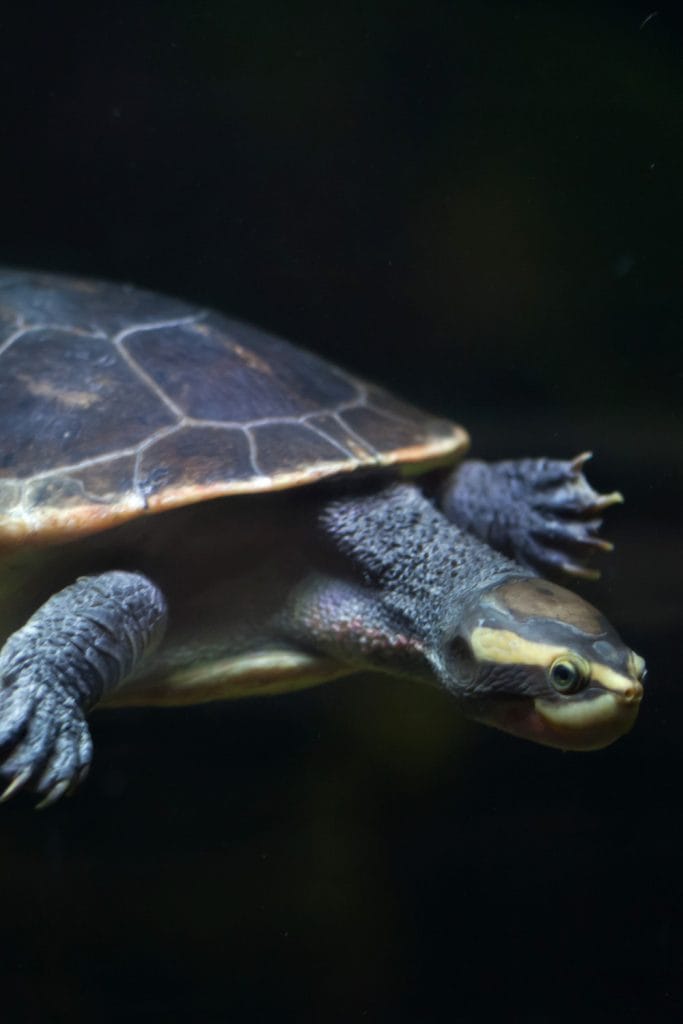
17. Pink-Bellied Side-Necked Turtle
- Scientific Name: Emydura subglobosa
- Size: Males 5-6 inches, Females 8-10 inches
- Lifespan: 30-50 years
- Care Level: Intermediate
- Tank Size: 55-75 gallons
- Water Temperature: 75-82°F
- Basking Temperature: 90-92°F
Origin and Appearance
Native to Australia and New Guinea. Named for stunning pink, red, or orange coloring on plastron, shell edges, and skin.
Physical Characteristics
Color: Standout feature is bright pink-to-red belly (plastron).
Shell: Dark brown, olive green, or black carapace with pink/red on marginal scutes.
Skin: Pink, red, or orange markings on dark background.
Sideneck: Like African Sidenecks, fold neck sideways rather than retracting straight back.
Sexual dimorphism: Females significantly larger than males.
Habitat Requirements
Aquatic lifestyle: Highly aquatic. Spend majority of time in water.
Tank: Minimum 55 gallons. 75 gallons better for large females.
Water depth: Deep water preferred. 12-18 inches.
Basking: Regular baskers despite aquatic nature.
Temperature: Warmer than North American species. 75-82°F water, 90-92°F basking.
Avoid cold: Temperatures below 70°F can cause respiratory infections.
Natural décor: River sand substrate, aquatic plants, rocks, driftwood create natural habitat.
Diet
Carnivorous in wild: Crustaceans, mollusks, aquatic insects.
Captive diet: Fish, insects, bloodworms, crickets, earthworms, commercial turtle pellets.
Some vegetables: May accept leafy greens.
Protein additions: Cooked chicken, lean beef (sparingly).
Avoid: Shrimp (low nutritional value despite turtles enjoying them).
Feeding: Daily for juveniles, every other day for adults.
Temperament
Social: Enjoy company of other turtles. Can be kept in groups with sufficient space.
Activity: Active swimmers. Entertaining to watch.
Personality: Generally calm and curious.
Handling: Tolerate brief handling but prefer to be left alone.
Hibernation
Do not hibernate. Maintain warm temperatures year-round. Sensitive to temperature drops.
Availability
Less common than North American species. May require ordering from specialized breeders or reptile shows. Check local regulations as some areas restrict Australian species.
Best For
Intermediate keepers. Those wanting colorful, unique turtle. People with warm environments or willing to maintain consistent heat. Owners wanting social species that can be kept in groups.
42 Prominent Turtle Species In The World: Infographic
Want to get a printable version of this infographic? Click here! If you want to use this infographic on your website, please link back to this page as source.
Choosing the Right Pet Turtle: Complete Guide
Factors to Consider Before Buying
Long-term commitment: Turtles live 20-100+ years. Will you provide care for decades? Do you have plans for turtle’s care if something happens to you?
Space requirements: Adult tank sizes range from 30 gallons (small species) to 150+ gallons (large species). Do you have space? Will you upgrade as turtle grows?
Financial commitment: Initial setup: $300-800. Annual maintenance: $200-500. Emergency vet care: $100-1,000+.
Lifestyle compatibility: Daily feeding and observation. Weekly tank cleaning. Are you home enough? Travel frequently?
Legal considerations: Many species restricted or prohibited in certain states. Check state wildlife regulations before purchasing.
Match Turtle to Your Experience Level
First-time turtle owner: Red-eared Slider, Painted Turtle, Yellow-bellied Slider, Eastern Box Turtle, Musk Turtle, Reeve’s Turtle.
Some experience (kept fish or reptiles): Map Turtle, African Sideneck, Caspian Pond Turtle, Mud Turtle, Spotted Turtle, Pink-bellied Sideneck.
Advanced (kept turtles before): Wood Turtle, Softshell Turtle, Diamondback Terrapin, large Cooters.
Space and Tank Size Matching
Limited space (20-40 gallons): Musk Turtle, Mud Turtle, Reeve’s Turtle, Spotted Turtle.
Moderate space (40-75 gallons): Painted Turtle, Map Turtle, Razor-backed Musk, Caspian Pond Turtle, African Sideneck.
Large space (75-150+ gallons): Red-eared Slider, Yellow-bellied Slider, Cooter Turtle, Softshell Turtle.
Outdoor space: Eastern Box Turtle (best kept in outdoor pens).
Turtle Selection by Personality Preference
Most interactive/personable: Reeve’s Turtle, Red-eared Slider, Box Turtle, Painted Turtle.
Shy/observational: Map Turtle, Wood Turtle, Musk Turtle, Spotted Turtle.
Active swimmers: Red-eared Slider, Painted Turtle, Cooter, Softshell, Pink-bellied Sideneck.
Calm/docile: Painted Turtle, Box Turtle, Reeve’s Turtle, Mud Turtle.
Bold/curious: Red-eared Slider, African Sideneck, Wood Turtle.
Appearance-Based Selection
Most colorful: Painted Turtle, Pink-bellied Sideneck, Yellow-bellied Slider, Spotted Turtle.
Unique appearance: Sideneck turtles (neck folds sideways), Softshell (no hard shell), Box Turtle (hinged shell closes).
Pattern appreciation: Painted Turtle (bright markings), Map Turtle (map-like patterns), Diamondback (diamond scutes), Spotted Turtle (yellow dots).
Classic turtle look: Red-eared Slider, Yellow-bellied Slider, Cooter.
Budget Considerations
Lower initial cost: Musk Turtle, Mud Turtle, Painted Turtle, Reeve’s Turtle ($20-50 for turtle, $200-400 setup).
Moderate cost: Red-eared Slider, Box Turtle, Map Turtle ($30-80 for turtle, $300-600 setup).
Higher cost: Wood Turtle, Diamondback Terrapin, Softshell, Pink-bellied Sideneck ($80-300 for turtle, $400-800+ setup).
Ongoing costs: All turtles require food ($10-30/month), electricity (lights, heater, filter), periodic replacements (bulbs, filter media), and potential vet visits ($100-1,000).
Legal and Ethical Considerations
Check legality first: Contact state Fish and Wildlife department. Many turtles are restricted or require permits.
Captive-bred only: Never purchase wild-caught turtles. Support conservation by buying only captive-bred individuals from reputable sources.
Documentation: Legitimate breeders provide paperwork proving captive breeding.
Endangered species: Wood Turtle, Spotted Turtle, Diamondback Terrapin have conservation concerns. Only acquire if legal and from documented captive breeding programs.
Salmonella consideration: All reptiles carry salmonella bacteria. Critical consideration for households with young children (under 5), elderly, or immunocompromised individuals.
Essential Turtle Care Requirements
Tank Setup Essentials
Tank size: Start with appropriate size for adult turtle, not hatchling. Upgrading is expensive and stressful.
Filtration: Most important equipment. Invest in quality canister filter rated for 2-3x your tank volume. Under-filtration is the most common mistake.
Heating: Submersible aquarium heater for water. Heat lamp for basking spot.
Lighting: UVB bulb (essential for calcium absorption and shell health). Replace every 6-12 months even if still producing visible light.
Basking platform: Must support turtle’s full weight. Large enough for turtle to dry completely. Positioned under heat lamp.
Water depth: General rule: 1.5-2 times shell length minimum for strong swimmers. Shallower for poor swimmers (Reeve’s, Musk, Mud).
Substrate: Optional. Bare bottom easiest to clean. If using substrate, choose large river rocks (too large to swallow) or fine sand (passes through system if swallowed). Avoid gravel (impaction risk).
Water Quality Management
Temperature: Species-specific but generally 72-82°F. Use reliable aquarium heater with thermostat.
Filtration: Run filter 24/7. Clean filter media according to manufacturer’s schedule.
Water changes: 25-30% weekly minimum, even with filtration. More frequent for messy species.
Testing: Test water parameters monthly (ammonia, nitrite, nitrate, pH). Ammonia and nitrite should be 0. Nitrate under 40 ppm.
Dechlorinator: Always treat tap water with dechlorinator before adding to tank.
Cleanliness: Remove uneaten food within 30 minutes. Scoop out feces when visible.
Feeding Guidelines
Commercial pellets: Foundation of diet for most species. Choose high-quality brand sized appropriately for turtle.
Variety essential: Pellets alone insufficient. Add protein (insects, fish, worms) and vegetables.
Protein sources: Live or frozen: earthworms, crickets, mealworms, waxworms, silkworms, small fish (guppies, goldfish, minnows), shrimp.
Vegetables: Dark leafy greens best: kale, collard greens, dandelion greens, mustard greens. Also: carrots, squash, green beans. Avoid iceberg lettuce (no nutrition).
Aquatic plants: Duckweed, water lettuce, water hyacinth. Live plants provide grazing opportunity.
Feeding frequency:
- Hatchlings (under 1 year): Daily
- Juveniles (1-3 years): Daily or every other day depending on species
- Adults (3+ years): Every other day or 3-4 times per week
Portion size: General rule: amount turtle can consume in 5 minutes, or head-sized portion of food.
Feeding location: Always feed in water. Aquatic turtles cannot swallow without water.
Supplements: Calcium powder dusted on food 2-3x weekly. Vitamin supplement 1-2x weekly (especially for indoor turtles).
Temperature and Lighting
Water temperature: Maintain within species-appropriate range. Use reliable heater with backup thermometer.
Basking temperature: 10-15°F warmer than water temperature. Typically 85-95°F depending on species.
UVB lighting: Essential. Provides UV radiation needed for vitamin D3 synthesis (necessary for calcium absorption). Without UVB, turtles develop metabolic bone disease.
UVB bulb types: Reptile-specific UVB bulbs. Either:
- Fluorescent tube (T5 or T8)
- Compact fluorescent bulb (CFL)
- Mercury vapor bulb (provides both heat and UVB)
UVB replacement: Replace every 6-12 months. UVB output degrades even when bulb still produces visible light.
Photoperiod: 10-12 hours light, 12-14 hours darkness daily. Use timer for consistency.
Heat lamp: Separate from UVB (unless using mercury vapor). Provides basking warmth. Use ceramic heat emitter, basking bulb, or infrared bulb.
Temperature monitoring: Multiple thermometers: one for water, one for basking spot, one for ambient air temperature.
Health Monitoring
Weekly health checks:
- Eyes: Clear, alert, no discharge
- Nostrils: Dry, no bubbles or discharge
- Mouth: Closes completely, no gaping
- Shell: Firm, no soft spots or wounds
- Skin: Clean, no redness or swelling
- Activity: Normal swimming, basking, eating
- Appetite: Eating regularly
Common health problems:
- Respiratory infection (symptoms: wheezing, mucus from nose/mouth, gaping, lethargic, floating lopsided)
- Shell rot (symptoms: soft spots, discoloration, foul odor from shell)
- Metabolic bone disease (symptoms: soft shell, deformed shell/limbs, lethargy)
- Vitamin A deficiency (symptoms: swollen eyes, weight loss)
- Parasites (symptoms: weight loss, visible worms in feces)
Veterinary care: Find exotic vet before emergency. Annual checkup recommended. Seek immediate care for: not eating 1+ weeks, respiratory symptoms, shell injuries, severe lethargy.
Tank Maintenance Schedule
Daily:
- Feed turtle
- Check temperatures
- Observe health and behavior
- Remove uneaten food
- Top off evaporated water
Weekly:
- 25-30% water change
- Wipe down tank walls
- Clean basking platform
- Test water temperature with backup thermometer
Monthly:
- Test water parameters (ammonia, nitrite, nitrate, pH)
- Deep clean basking area
- Inspect equipment (filter, heater, lights)
- Check UVB bulb age (replace if 6-12 months old)
Quarterly:
- Complete filter cleaning (rinse media, check impeller)
- Inspect substrate (if present)
- Check all equipment for wear
Annually:
- Replace UVB bulb (even if still working)
- Deep clean entire tank (remove turtle, scrub everything, refill)
- Veterinary checkup
- Evaluate and upgrade equipment as needed
Common Mistakes to Avoid
- Tank too small: Most common mistake. Turtles grow quickly. Small tanks stunt growth and cause health problems. Always buy for adult size.
- Insufficient filtration: Turtle tanks need more filtration than fish tanks. Turtles are messy. Use filter rated for 2-3x your tank volume.
- No UVB lighting: Without UVB, turtles develop metabolic bone disease (soft shell, deformed bones). UVB is not optional.
- Improper diet: Feeding only commercial pellets or only protein causes health problems. Variety is essential.
- Poor water quality: Dirty water causes illness. Regular water changes are mandatory.
- Handling too much: Turtles are not handling pets like dogs or cats. Excessive handling causes stress.
- Tank mates: Don’t keep turtles with fish (turtles eat fish). Don’t keep different turtle species together (different care needs, size differences cause injury).
- Outdoor release: Never release pet turtles outdoors. They cannot survive, spread disease to wild turtles, and it’s illegal.
- Skipping quarantine: New turtles should be quarantined 30-90 days before introducing to existing turtles. Prevents disease spread.
- Buying wild-caught: Wild-caught turtles are stressed, may carry diseases, don’t adapt to captivity, and contribute to population decline. Always buy captive-bred.
- Impulse purchase: Turtles are 20-100 year commitments. Research thoroughly before buying.
Where to Buy Pet Turtles
Reputable breeders: Best option. Breeders produce healthy, captive-bred turtles. Can answer questions and provide care information.
Reptile expos: Meet multiple breeders. See turtles in person before buying. Ask questions directly.
Specialty reptile stores: Better than chain pet stores. Staff usually more knowledgeable. Higher quality care for animals.
Online reptile retailers: Convenient but can’t see turtle before purchase. Choose established companies with good reviews. Overnight shipping in appropriate temperatures.
Avoid:
- Wild-caught turtles (unethical, often sick, illegal in many cases)
- Pet stores with sick/overcrowded animals
- Sellers without documentation proving captive breeding
- Prices that seem too good to be true
- Sellers who won’t answer care questions
Red flags:
- Multiple species overcrowded in one tank
- Cloudy or dirty water
- Turtles with visible health issues (swollen eyes, damaged shells, lethargic)
- No information about turtle’s age, sex, or care requirements
- Unwillingness to provide health guarantee
- Pressure to buy immediately
Questions to ask seller:
- Is this turtle captive-bred? (Documentation available?)
- How old is the turtle?
- What has it been eating?
- Has it been to a vet?
- Can you provide care sheet?
- What health guarantee do you offer?
- Will you take turtle back if I cannot keep it?
Frequently Asked Questions
What is the best pet turtle for beginners?
Red-eared Sliders, Painted Turtles, and Eastern Box Turtles are best for beginners. These species are hardy, readily available, have moderate care requirements, and tolerate common beginner mistakes better than sensitive species.
For limited space, Common Musk Turtles are excellent beginner turtles requiring only 20-30 gallon tanks.
What is the friendliest pet turtle?
Reeve’s Turtles are considered the friendliest, as they tolerate and sometimes enjoy handling—unusual for aquatic turtles.
Red-eared Sliders and Painted Turtles are also personable, recognizing owners and showing interest in human activity. Eastern Box Turtles can be friendly but this varies greatly by individual personality.
What is the easiest turtle to take care of?
Common Musk Turtles and Common Mud Turtles are easiest to care for due to small size (requiring only 20-30 gallon tanks), simple diet, and lower maintenance needs. They’re hardy, don’t bask as frequently as other species, and are forgiving of minor care mistakes.
How long do pet turtles live?
Pet turtle lifespans range from 20-100+ years depending on species. Most aquatic species (Sliders, Painted, Map) live 20-40 years. Box Turtles can live 50-100 years. Musk and Mud Turtles average 30-50 years. Proper care significantly extends lifespan; poor care shortens it substantially.
How big of a tank does a turtle need?
Tank size depends on species. Small species (Musk, Mud, Reeve’s) need 20-40 gallons as adults. Medium species (Painted Turtles) need 55-75 gallons. Large species (Red-eared Sliders, Cooters) need 75-150 gallons. General rule: 10 gallons per inch of shell length. Bigger is always better.
Can different turtle species live together?
Generally no. Different species have different temperature, diet, and behavioral needs.
Size differences lead to competition and injury. Even same-species cohabitation requires caution—only compatible if tank is large enough (add 40-50 gallons per additional turtle) and turtles are similar size and temperament.
Do pet turtles need land and water?
Most pet turtles are aquatic or semi-aquatic, requiring both water for swimming and a dry basking area.
The ratio varies: fully aquatic species (Sliders, Painted) need 90% water, 10% land. Semi-aquatic species (Musk, Mud, Spotted) need 70% water, 30% land. Box Turtles are primarily terrestrial, needing mostly land with shallow water dish.
Can you potty train a turtle?
No, turtles cannot be potty trained. They defecate when and where they need to. Most aquatic turtles defecate in water while swimming. This is why powerful filtration and regular water changes are essential for turtle keeping.
Do turtles recognize their owners?
Yes, many turtles recognize their owners. Red-eared Sliders, Painted Turtles, and Box Turtles learn to associate humans with food and may swim to tank front, follow movements, or show excitement when owners approach. Recognition improves with consistent daily interaction.
Are turtles high maintenance?
Turtles are moderate to high maintenance. They require: large tanks (expensive setup), powerful filtration (ongoing cost), daily feeding, weekly water changes, temperature monitoring, and long-term commitment (20-50+ years). While less demanding than dogs, they’re more demanding than fish. Not low-maintenance pets.
Can I keep a turtle in a small tank?
Temporarily yes (hatchlings in 20-30 gallons), but not long-term. Small tanks stunt growth, cause stress, lead to health problems, and make water quality difficult to maintain. Always plan for adult size. Under-sized tanks are the most common cause of health issues in pet turtles.
Why is my turtle not eating?
Common reasons: water temperature too cold (slows metabolism), stress from new environment (wait 1-2 weeks), illness (respiratory infection, parasites), wrong food offered, or preparing to hibernate (if temperatures dropped). If turtle doesn’t eat for 2+ weeks, consult exotic veterinarian.
Do pet turtles carry diseases?
Yes, all reptiles carry Salmonella bacteria naturally in their digestive systems. This doesn’t make them sick but can transmit to humans through contact.
Critical consideration for homes with children under 5, elderly, or immunocompromised individuals. Prevention: wash hands after handling turtle or tank items, don’t kiss turtles, don’t clean tank in kitchen sink.
Conclusion
Choosing from 17 different pet turtle species may seem overwhelming, but understanding each species’ unique requirements, personality traits, and care needs helps narrow the options.
Red-eared Sliders, Painted Turtles, and Box Turtles remain the most popular pet turtles for good reason—they’re hardy, available, and relatively straightforward to care for as long as you provide proper habitat, diet, and long-term commitment.
Remember that all turtles require significant investment in both setup costs (tanks, filters, lights) and time commitment (daily feeding, weekly maintenance, decades of care).
They are not low-maintenance pets, but for dedicated owners willing to provide proper care, turtles offer rewarding, long-term companionship.
Before purchasing any turtle species:
- Research the specific species thoroughly
- Verify legality in your state
- Ensure you have adequate space and budget
- Buy only captive-bred individuals from reputable sources
- Set up appropriate habitat BEFORE bringing turtle home
- Locate exotic veterinarian in advance
With proper care, your pet turtle will be a fascinating companion for 20 to 100+ years—a truly unique experience in the world of pet keeping.
Related Articles
Red-Eared Slider Complete Care Guide
Types of Painted Turtles: Complete Subspecies Guide
Box Turtle Diet and Feeding Guide
Turtle Taxonomy: Complete Classification Guide

About Author
Muntaseer Rahman started keeping pet turtles back in 2013. He also owns the largest Turtle & Tortoise Facebook community in Bangladesh. These days he is mostly active on Facebook.


